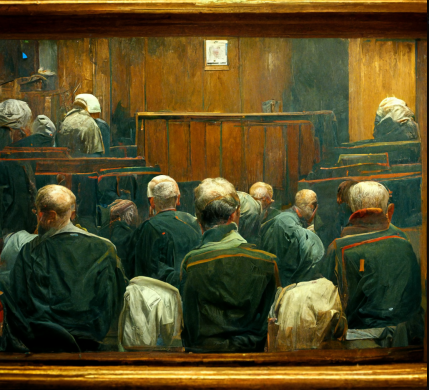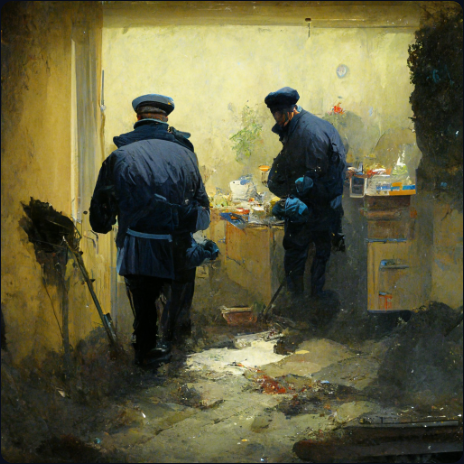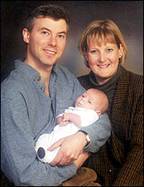Bryan Han | October 19, 2022
We like to think that we are correct when it comes to science. Whether it is some new dieting fad on social media that justifies itself based on some loosely correlated ideas from science, arguments over how to parent our children, or a news article proclaiming that it has found both a cause of and a cure for cancer, we simply let ourselves believe what everyone else believes if it is attached to the label of “science”. After all, what would the consequences of treating the idea of science as a completely all-knowing judge of reality be?
What if that judge happened to declare you guilty of a crime that you never committed?
The Case

Your name is Sally Clark. You are a successful British lawyer with a husband in the same profession, and you have set up a law firm in Manchester. After a successful career, tragedy strikes as your firstborn, a healthy baby boy, suddenly falls unconscious and dies before he could be transported to the hospital in a rare but classic case of SIDS, or Sudden Infant Death Syndrome. After grieving your loss, you and your husband welcome your second child into the world, only to lose him soon after to SIDS as well.

This time, instead of pity, you receive handcuffs and a notice that you are under arrest for the murder of your two children. On the prosecution’s side is the pre-eminent professor of pediatrics Professor Sir Roy Meadow. His years of work in pediatrics included introducing the concept of Munchausen Syndrome by Proxy, gaining an award from the British Paediatric Association, obtaining a professional chair at the St Jame’s University Hospital, and even a knighthood in recognition of his work in the field. Not only that, just a few years prior, his expert testimony was used to convict a British nurse who was also accused of murdering several children. By all metrics, Dr. Meadow’s was the spokesperson for science when it came to this case, and the public believed him.

According to Dr. Meadow, the chances of SIDS occurring in a low risk household (one with no smokers and a present wage earner in the family) was 1 in 8,543. He then claimed that because each case of SIDS is an independent event, the chances of two cases of SIDS in a single family was less than 1 in 73 million. Given that there were about 700,000 births per year in Britain, that would mean that two cases of SIDS in a family would be a once-in-a-century event.
Despite your insistence on your innocence, your face had already been spread throughout the tabloids, and you are publicly condemned as a rich, child-murdering lawyer by society. After unquestioningly accepting Dr. Meadow’s expert testimony, the jury is thoroughly convinced of your guilt, and you are sent to prison, where your status as a child-murderer and a daughter of a police officer has marked you as a target by the inmates. You lose your job and your reputation, and your husband quits his job to be closer to you, while your family is forced to sell the family house to pay for your legal fees.
Seeds of Doubt
In the aftermath of your trial, the scientific community begins to dispute your guilt. For one, SIDS is a diagnosis of exclusion which means that it is only diagnosed in cases where the cause of death remains unknown following an “investigation, an autopsy, and a review of the clinical history”. Diagnosing a baby with SIDS after it has passed away is essentially the same as saying that it had passed for unknown reasons. Dr. Meadows may have been a widely renowned expert, but that does not mean he knew something that the rest of humanity did not. He was going out of line and abusing his reputation when he made the unsupported claim that each case of SIDS was independent. If anything, the presence of multiple risk factors associated with SIDs should suggest that cases of SIDS are not actually independent of each other, and that both SIDS and the risk factors are correlated to some unknown genetic or environmental factors which may make some families more likely to experience SIDS than others. Dr. Meadow’s methodology of arriving at his figure was incorrect.
Second, even if his assertion of the chances of such a case happening were true, he, the prosecutor, and the jury had fallen into the prosecutor’s fallacy. The prosecutor’s fallacy is the false assumption that the probability of being innocent given the evidence shown is the same as the probability that evidence against you would appear even if you were innocent. To explain this in detail, we can refer to the diagram below for a simpler example.
The Prosecutor’s Fallacy

Imagine that you are in a town of 1000 people, and there is a burglar on the loose. A sample of the burglar’s blood was found in the crime scene, and its type happened to match yours. Only 10% of the town had that blood type, so the prosecution argues that there is a 90% chance that you are the burglar.
Although it may look like there would only be a 10% chance that you are innocent if you were found to have the same blood type as the burglar, the prosecution has made a logical fallacy. If 10% of the town had the same blood type, then there were 99 innocent people walking around with the same blood type as the killer and the killer themself. If we create a table listing the distribution of people by blood type and innocence, we would arrive at the figure below.
Prior to matching your blood type with that of the burglar, most people would agree that there was only a 1 in 1000 chance that it was you, because you could have existed in any of these boxes (Innocent and does not match the blood type, innocent but happens to have the correct blood type, is the burglar and has the correct blood type). The chance of you being in each possible box has been written below.
By matching your blood type with that of the burglar, we can only narrow you down into the row of people who match the burglar ’s blood type. The chances of you being in each possible box has been listed below.
There are still 100 people in this row but only 1 burglar, so the actual chances of you being innocent is a resounding 99% even after matching the burglar’s blood type, down from the previous 99.9% before your blood type was matched. The prosecutor has incorrectly assumed that the chances that you were innocent after matching the burglar’s blood type (99/100 or 99%) was the same as the chances that you happened to match the blood type while being innocent (99/900 or about 10%).
Returning to reality, we can depict your (Sally Clark’s) situation in a similar method as we did for the example above.

In your case, although you had been narrowed down to the “Lose children unexpectedly” row, you could either be in Scenario 2 or 3, the prosecution had to prove that the chances of your case being scenario 3 was much higher than the chances of your case being in scenario 2. Instead, by equating the chances of you being innocent to the chances that an innocent person loses their children unexpectedly, scenario 2 to scenario 1, the prosecution, their key witness, and most importantly, the jury, had fallen prey to the prosecutor’s fallacy. In fact, later reviews will declare that the chances that you had indeed had 2 children die of SIDS instead of murder is still 9 to 1. This means that the prosecution never proved that you were guilty beyond a reasonable doubt. Even with all of this, the jury and the public take what Dr. Meadow claims without questioning, and they declare you guilty of murdering your children. Your life as you know it has ended.
The Aftermath
We take mental shortcuts everyday, and one of them happens to be using the label of “science” to denote something to be undeniably true. While it is impractical to have an expert understanding of every field of science and the credibility of experts in a field should outweigh the credibility of those outside of it, we should not confuse credibility with perfection.
The case of Sally Clark provides a classic example of what goes wrong when we make that mistake. Although some people think that cases like this could have been avoided if the jury had known about the prosecutor’s fallacy or had an understanding of the epidemiology of SIDS, this is a narrow conclusion to draw. There are countless examples of counterintuitive concepts in the field of statistics alone, before one considers the many other fields of study used in criminal justice trials. There is simply no way we could ever avoid this issue in the future by simply “knowing more”, because there will always be something more that all of us will have to know.
In fact, the true interpretation, if there is any, of the case of Sally Clark, would be that our understanding of science is flawed. We use science as a lazy shorthand for reality and never stop to think about what we hear to be true. We think that we can know or have “more Science on our side”, but that is a fundamental misunderstanding of the nature of Science. Science is the pursuit of knowledge through the scientific method. In that case, to accept the scientific method is to declare that we know nothing in a universe potentially full of infinitely many and unknowable truths. The conclusions we derive from the scientific method are arduous to get, misleading, and often wrong, but the hope is that through infinite iterations of making assertions and being proven wrong, we may approach some fundamental truth.
After bringing in experts, debating the arguments against her innocence in diverse fields from statistics to biology, and a revelation that the prosecution had evidence that was not properly revealed, the scientific community helped Sally Clark present a successful case to overturn her conviction. We had finally ended up somewhere closer to the truth, as science promises to do. Yet, she had been wrongfully convicted in the first place because we perceived science to be something that it was not, the infallible and clear arbitrator of reality. In the court of justice, where what we deem as the truth has the power to condemn the innocent and set the guilty free, we had mistakenly asked science, a system that chases after the ever-expanding goal of the truth, to give us a final answer, something that science was never meant to do. Though Sally Clark’s criminal record was eventually restored, the consequences of her conviction would never go away.
Sally Clark was sentenced to life in prison for the murder of her two children. Despite her hardships and a failed appeal, she managed to win her second appeal with the backing of the scientific community, and by 2003, her charges were overturned and she was set free. However, her life had already ended. She had already lost 4 years of her life wrongfully imprisoned, and her, along with her husband’s, careers, social lives, and reputations were as dead as her children because of the same legal system her family had believed in and dedicated their lives to. In 2007, Sally Clark was found dead in her home. Her cause of death was ruled as alcohol poisoning.

http://forejustice.org/wc/sally_clark_freed.htm
(Right) Steve Clark
(Left) Sally Clark
(Baby) Their first son, Christopher




Interesting and thought-provoking read! Thanks Bryan!
What a powerful article. Thank you for helping us think critically about the role of both science and statistics, Bryan!